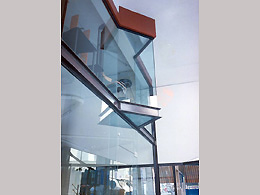ARCHITECTURAL REVIEW

20 May, 2010
A multi-deterministic approach to architecture
Why always one idea over a medley of ideas?
Undeniably, one's architectural philosophy of approach is a form giver. The idea one is immersed in, or the path or creed he pursues, culminates in a certain stylistic solution.
It seems that architecture is always in need of a dogma to progress or at least to assert itself. A parade of various historical movements can easily attest to that (Man is the Measure, Form Follows Function, Function Follows Form, etc).
What is peculiar though is when one attempts to put forth an all inclusive creed, he is viewed with skepticism. It is fine to claim that architecture should be this or that, naturally to the exclusion of other determinants or factors, but when some sort of a holistic view is presented, it is somehow immediately ignored or discredited.
For instance, some believe architecture should focus on the minimal or the transparent, others believe architecture should be environmentally friendly, while some others believe it should be socially accountable. When one entertains though the rather logical thought that perhaps architecture should be all of the above, or at least more that a single focus, disbelief arises, he is rather perceived as anachronistic.
At instances architects have been very polemical on the issue, defending their single stance adamantly. [1] This holds true especially for the later part of the 19th. Century, as well as, for the whole of the 20th. Century.
The profession seems to feel uncomfortable considering more than a single viewpoint at a time. Perhaps it is felt that such an approach runs contrary to theory, or lacks a clear sense of direction. As a result, today most - practitioners as well as potential clients - embrace architecture as this, while tomorrow, as that... In the process, it is perceived that architecture is not unlike fad, styles coming and going.
A designer deserves the right to place an emphasis where he feels. This laconic portrayal of thoughts does not wish to deny this. But at the same time, perhaps architecture will truly liberate itself, or attain greater credibility, when it can consciously detach itself from myopic fixations. Aren't layers of multiple, simultaneous readings, more interesting anyway, that a straight forward predictable scenario? Why always one idea over a medley of ideas?
Michael A. Vidalis
Architect, MArch.
Note
[1] Peter Eisenman, my teacher, was very vocal on the issue. His architecture whether one embraces it or not, undeniably, is the result of his unique theoretical approach.
Photo credit: Vidalis + Tsokopoulos & associates
Related articles:
- “anti∙Architecture: Architectural Monologues” ( 09 June, 2008 )
- Architecture: contemplating its future ( 12 June, 2010 )
- Social Spaces by a Social Architects? ( 17 January, 2015 )










